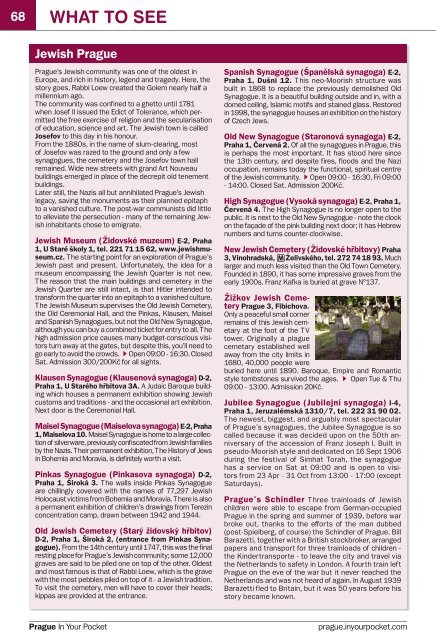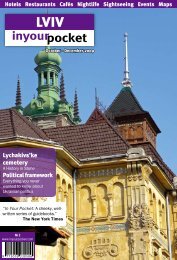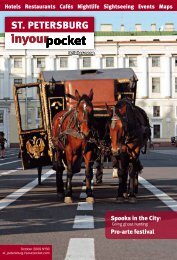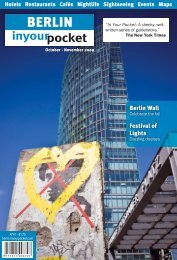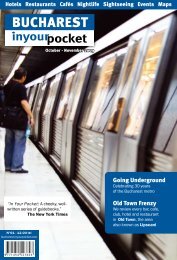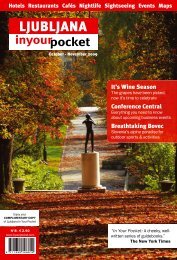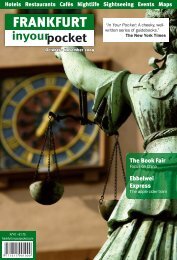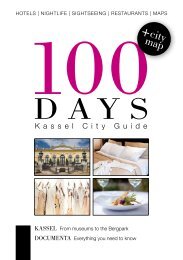Create successful ePaper yourself
Turn your PDF publications into a flip-book with our unique Google optimized e-Paper software.
68 WHAT TO SEE<br />
Jewish Prague<br />
Prague’s Jewish community was one of the oldest in<br />
Europe, and rich in history, legend and tragedy. Here, the<br />
story goes, Rabbi Loew created the Golem nearly half a<br />
millennium ago.<br />
The community was confined to a ghetto until 1781<br />
when Josef II issued the Edict of Tolerance, which permitted<br />
the free exercise of religion and the secularisation<br />
of education, science and art. The Jewish town is called<br />
Josefov to this day in his honour.<br />
From the 1880s, in the name of slum-clearing, most<br />
of Josefov was razed to the ground and only a few<br />
synagogues, the cemetery and the Josefov town hall<br />
remained. Wide new streets with grand Art Nouveau<br />
buildings emerged in place of the decrepit old tenement<br />
buildings.<br />
Later still, the Nazis all but annihilated Prague’s Jewish<br />
legacy, saving the monuments as their planned epitaph<br />
to a vanished culture. The post-war communists did little<br />
to alleviate the persecution - many of the remaining Jewish<br />
inhabitants chose to emigrate.<br />
Jewish Museum (Židovské muzeum) E-2, Praha<br />
1, U Staré školy 1, tel. 221 71 15 62, www.jewishmuseum.cz.<br />
The starting point for an exploration of Prague’s<br />
Jewish past and present. Unfortunately, the idea for a<br />
museum encompassing the Jewish Quarter is not new.<br />
The reason that the main buildings and cemetery in the<br />
Jewish Quarter are still intact, is that Hitler intended to<br />
transform the quarter into an epitaph to a vanished culture.<br />
The Jewish Museum supervises the Old Jewish Cemetery,<br />
the Old Ceremonial Hall, and the Pinkas, Klausen, Maisel<br />
and Spanish Synagogues, but not the Old New Synagogue,<br />
although you can buy a combined ticket for entry to all. The<br />
high admission price causes many budget-conscious visitors<br />
turn away at the gates, but despite this, you’ll need to<br />
go early to avoid the crowds. QOpen 09:00 - 16:30. Closed<br />
Sat. Admission 300/200Kč for all sights.<br />
Klausen Synagogue (Klausenová synagoga) D-2,<br />
Praha 1, U Starého hřbitova 3A. A Judaic Baroque building<br />
which houses a permanent exhibition showing Jewish<br />
customs and traditions - and the occasional art exhibition.<br />
Next door is the Ceremonial Hall.<br />
Maisel Synagogue (Maiselova synagoga) E-2, Praha<br />
1, Maiselova 10. Maisel Synagogue is home to a large collection<br />
of silverware, previously confiscated from Jewish families<br />
by the Nazis. Their permanent exhibition, The History of Jews<br />
in Bohemia and Moravia, is definitely worth a visit.<br />
Pinkas Synagogue (Pinkasova synagoga) D-2,<br />
Praha 1, Široká 3. The walls inside Pinkas Synagogue<br />
are chillingly covered with the names of 77,297 Jewish<br />
Holocaust victims from Bohemia and Moravia. There is also<br />
a permanent exhibition of children’s drawings from Terezin<br />
concentration camp, drawn between 1942 and 1944.<br />
Old Jewish Cemetery (Starý židovský hřbitov)<br />
D-2, Praha 1, Široká 2, (entrance from Pinkas Synagogue).<br />
From the 14th century until 1747, this was the final<br />
resting place for Prague’s Jewish community; some 12,000<br />
graves are said to be piled one on top of the other. Oldest<br />
and most famous is that of Rabbi Loew, which is the grave<br />
with the most pebbles piled on top of it - a Jewish tradition.<br />
To visit the cemetery, men will have to cover their heads;<br />
kippas are provided at the entrance.<br />
Spanish Synagogue (Španělská synagoga) E-2,<br />
Praha 1, Dušní 12. This neo-Moorish structure was<br />
built in 1868 to replace the previously demolished Old<br />
Synagogue. It is a beautiful building outside and in, with a<br />
domed ceiling, Islamic motifs and stained glass. Restored<br />
in 1998, the synagogue houses an exhibition on the history<br />
of Czech Jews.<br />
Old New Synagogue (Staronová synagoga) E-2,<br />
Praha 1, Červená 2. Of all the synagogues in Prague, this<br />
is perhaps the most important. It has stood here since<br />
the 13th century, and despite fires, floods and the Nazi<br />
occupation, remains today the functional, spiritual centre<br />
of the Jewish community. QOpen 09:00 - 16:30, Fri 09:00<br />
- 14:00. Closed Sat. Admission 200Kč.<br />
High Synagogue (Vysoká synagoga) E-2, Praha 1,<br />
Červená 4. The High Synagogue is no longer open to the<br />
public. It is next to the Old New Synagogue - note the clock<br />
on the façade of the pink building next door; it has Hebrew<br />
numbers and turns counter-clockwise.<br />
New Jewish Cemetery (Židovské hřbitovy) Praha<br />
3, Vinohradská, MŽelivského, tel. 272 74 18 93. Much<br />
larger and much less visited than the Old Town Cemetery.<br />
Founded in 1890, it has some impressive graves from the<br />
early 1900s. Franz Kafka is buried at grave N°137.<br />
Žižkov Jewish Cemetery<br />
Prague 3, Fibichova.<br />
Only a peaceful small corner<br />
remains of this Jewish cemetary<br />
at the foot of the TV<br />
tower. Originally a plague<br />
cemetary established well<br />
away from the city limits in<br />
1680, 40,000 people were<br />
buried here until 1890. Baroque, Empire and Romantic<br />
style tombstones survived the ages. Q Open Tue & Thu<br />
09:00 - 13:00. Admission 20Kč.<br />
Jubilee Synagogue (Jubilejní synagoga) I-4,<br />
Praha 1, Jeruzalémská 1310/7, tel. 222 31 90 02.<br />
The newest, biggest, and arguably most spectacular<br />
of Prague’s synagogues, the Jubilee Synagogue is so<br />
called because it was decided upon on the 50th anniversary<br />
of the accession of Franz Joseph I. Built in<br />
pseudo-Moorish style and dedicated on 16 Sept 1906<br />
during the festival of Simhat Torah, the synagogue<br />
has a service on Sat at 09:00 and is open to visitors<br />
from 23 Apr - 31 Oct from 13:00 - 17:00 (except<br />
Saturdays).<br />
Prague’s Schindler Three trainloads of Jewish<br />
children were able to escape from German-occupied<br />
Prague in the spring and summer of 1939, before war<br />
broke out, thanks to the efforts of the man dubbed<br />
(post-Spielberg, of course) the Schindler of Prague. Bill<br />
Barazetti, together with a British stockbroker, arranged<br />
papers and transport for three trainloads of children -<br />
the Kindertransporte - to leave the city and travel via<br />
the Netherlands to safety in London. A fourth train left<br />
Prague on the eve of the war but it never reached the<br />
Netherlands and was not heard of again. <strong>In</strong> August 1939<br />
Barazetti fled to Britain, but it was 50 years before his<br />
story became known.<br />
Prague <strong>In</strong> <strong>Your</strong> <strong>Pocket</strong> prague.inyourpocket.com<br />
House at the White Unicorn (Dům u bílého<br />
jednorožce) E-3, Praha 1, Staromestské nám. 15,<br />
MStaroměstská, tel. (+420) 222 31 39 09, www.<br />
daliexhibition.cz. This central exhibition space caters to the<br />
big names, and not only in Czech art. Much to the delight of<br />
the world’s moustache aficionados, this house is exhibiting<br />
a selection of graphics, sculpture and pottery from Salvador<br />
Dali. Another area is dedicated to Alfons Mucha, the master<br />
of Art Nouveau while a neighbouring house (E-3, Praha 1,<br />
Celetná 9, tel. 222 31 30 64) hosts a selection of images<br />
from the infamous photographer Jan Saudek. QOpen 10:00<br />
- 20:00. Admission 150/70Kč. Saudek & Mucha 150/70Kč<br />
or 250/120Kč combined ticket.<br />
Jewellery Collection C-2, Praha 1, Cihelná 2b, tel.<br />
(+420) 221 45 13 33. The Hergetova cihelna (brickyard<br />
building) near Karlův most, houses an exhibition from the<br />
collection of the Museum of Decorative Arts. This incredible<br />
array of pieces illustrating the the art of jewellery design from<br />
the 17th century includes items from Fabergé and Tiffany.<br />
QOpen 10:00 - 18:00.<br />
Jiří Světská Gallery J-3, Praha 1, Biskupský dvůr 6,<br />
MNám. Republiky, tel. (+420) 222 31 10 92, www.<br />
jirisvestka.com. A private gallery that promotes modern<br />
and contemporary art in the Czech Republic and internationally<br />
and has garnered renown by introducing Czech artists to<br />
major galleries overseas. <strong>In</strong> addition to their collections, and<br />
exhibitions, it has a large collection of art periodicals plus art<br />
and architectural titles in Czech and English. Q Open 12:00 -<br />
18:00, Sat 11:00 - 18:00. Closed Sun & Mon.<br />
Kafka Museum C-2, Praha<br />
1, Hergetova Cihelna, Cihelná<br />
2b, tel. (+420) 257 53<br />
55 07, www.kafkamuseum.<br />
cz. This new collection entitled<br />
The City of K. Franz Kafka and<br />
Prague opened in Barcelona<br />
in 1999, transferred to the<br />
Jewish Museum in New York in 2002 and opened in Prague<br />
in the summer of 2005. This museum illuminates the crucial<br />
relationship between the man and the city. It is divided into<br />
Existential Space where we see what Prague did with and<br />
to Kafka, and Imaginary Topography which looks at how<br />
Kafka creates enigmatic layers of his city through first editions<br />
and letters, diaries and manuscripts, and audiovisual pieces.<br />
QOpen 10:00 - 18:00. Admission 120/60Kč.<br />
Kampa Museum B-3, Praha 1, U Sovových mlýnů 2,<br />
tel. (+420) 257 28 61 47, www.museumkampa.cz.<br />
Museum Kampa is located on the west bank of the Vltava in<br />
the shadow of Prague Castle. The museum has on display<br />
three major permanent exhibitions, featuring works by the<br />
pioneering abstract artist František Kupka, Cubist sculptor<br />
Otto Gutfreund and a large collection of modern works dating<br />
from the 1950’s to present day by Central European artists.<br />
They also have temporary exhibits. The museum has a beautiful<br />
restaurant with an outside terrace overlooking the river.<br />
A visit to Museum Kampa is definitely worthwhile. QOpen<br />
10:00 - 18:00. Admission varies according to exhibition.<br />
Langhans Galerie I-4, Praha 1, Vodičkova 37,<br />
MMůstek, tel. (+420) 222 92 93 33, www.langhansgalerie.cz.<br />
The sleek lined, clean-cut minimalism of<br />
a award-winning symbiosis of old and new architecture is<br />
complemented beautifully by the photographic exhibitions<br />
hanging on its walls. Behind the Foto Škoda store, which in<br />
itself is a museum of old and new cameras. QOpen 12:00<br />
- 19:00. Closed Mon. Admission 60/20Kč.<br />
prague.inyourpocket.com<br />
WHAT TO SEE<br />
Leica Gallery Praha 1, Školská 28, MMůstek, tel.<br />
(+420) 608 96 35 24, www.lgp.cz. Their new Gallery will<br />
be open again on 7 May. Check out their cafe, bookshop, and<br />
of course some of the best photo exhibits in town. QOpen<br />
11:00 - 21:00. Closed Sun.<br />
Mánes Exhibition Hall G-5, Praha 1, Masarykovo<br />
nábřeží 250, tel. (+420) 224 93 0 7 54, www.nadacecfu.cz.<br />
A major exhibition space for all forms of modern<br />
and contemporary art from the Czech Art Fund Foundation.<br />
QOpen 10:00 - 18:00. Closed Mon, Sun.<br />
Miniatures Museum Praha 1, Strahovské nádvoří<br />
11, tel. (+420) 233 35 23 71, www.muzeumminiatur.<br />
com. This museum contains odd scribblings on grains<br />
of rice, the Lord’s Prayer written on one human hair, the<br />
world’s smallest book, and minitures of masterpieces.<br />
They have magnifying glasses. QOpen 09:00 - 17:00.<br />
Admission 50Kč.<br />
Mozart Museum (Bertramka) Praha 5, Mozartova<br />
169, MAnděl, tel. (+420) 257 31 67 53, www.<br />
bertramka.cz. This museum, dedicated to the Austrian<br />
Wunderkind and the family he lived with in Prague, is located<br />
in a 17th century villa. The villa, owned by the Dušek family,<br />
is where Mozart wrote Don Giovanni. There’s a bust of the<br />
famed composer in the villa gardens, and music scores and<br />
concert posters are preserved inside. QOpen 09:30 - 17:00.<br />
Admission 110/50Kč.<br />
Mucha Museum F-4, Praha 1, Panská 7, MMůstek,<br />
tel. (+420) 221 45 13 33, www.mucha.cz. Mucha shaped<br />
the Art Nouveau movement with his groundbreaking (and<br />
often stolen from Paris’ streets) posters for actress Sarah<br />
Bernhardt and the Theatre de la Renaissance, and has<br />
some renown as a photographer with the studies for his<br />
various masterpieces. He also has an excellent shot of a<br />
trouserless Paul Gauguin at a harmonium. A fitting tribute to<br />
artistic genius, whether you prefer his pastel seasons, the<br />
accusing desperation of the Slav Epic (his incomplete and<br />
huge magnum opus of which there are strangely no photos),<br />
or modern prints on everything from coasters to mousepads.<br />
Don’t miss the short biographical film. QOpen 10:00 - 18:00.<br />
Admission 120Kč.<br />
Museum of Communism F-4, Praha 1, Na Příkopě 10,<br />
tel. (+420) 224 21 29 66, www.muzeumkomunismu.cz.<br />
The posters featuring the workers of the state, featuring a<br />
mix of socialist-realism which produces simultaneous hilarity<br />
and dark brooding, are almost worth the entrance fee on<br />
their own. Errant and erratic household objects can give<br />
this place an incomplete feel, however, the photos and<br />
historical information on display are a minimalist introduction<br />
to the events of this period. QOpen 09:00 - 21:00.<br />
Admission 180Kč.<br />
Muzeum Karlova Mostu (Charles Bridge<br />
Museum) D-3, Praha 1, Křížovnické nám. 3,<br />
MStaroměstská, tel. (+420) 739 30 95 51, www.<br />
muzeumkarlovamostu.cz. This new museum, opened<br />
to coincide with the 650th anniversary of the building<br />
of Charles Bridge in 1357 (the clever number logo is no<br />
coincidence, 135797531. The first stone was laid at<br />
05:31 on 9 July). English texts are available to explain the<br />
unique Knights of the Red Cross hospital location, their<br />
church and crypt, various bridges; an arch and pillar of the<br />
even older (1158 - 1172) Judit Bridge, and others in the<br />
region, construction techniques, etc. Charles Bridge, with<br />
its statues and history, is the focus but there is so much<br />
more. Fascinating. QOpen 10:00 - 18:00. 150/70Kč.<br />
October - November 2009<br />
69


